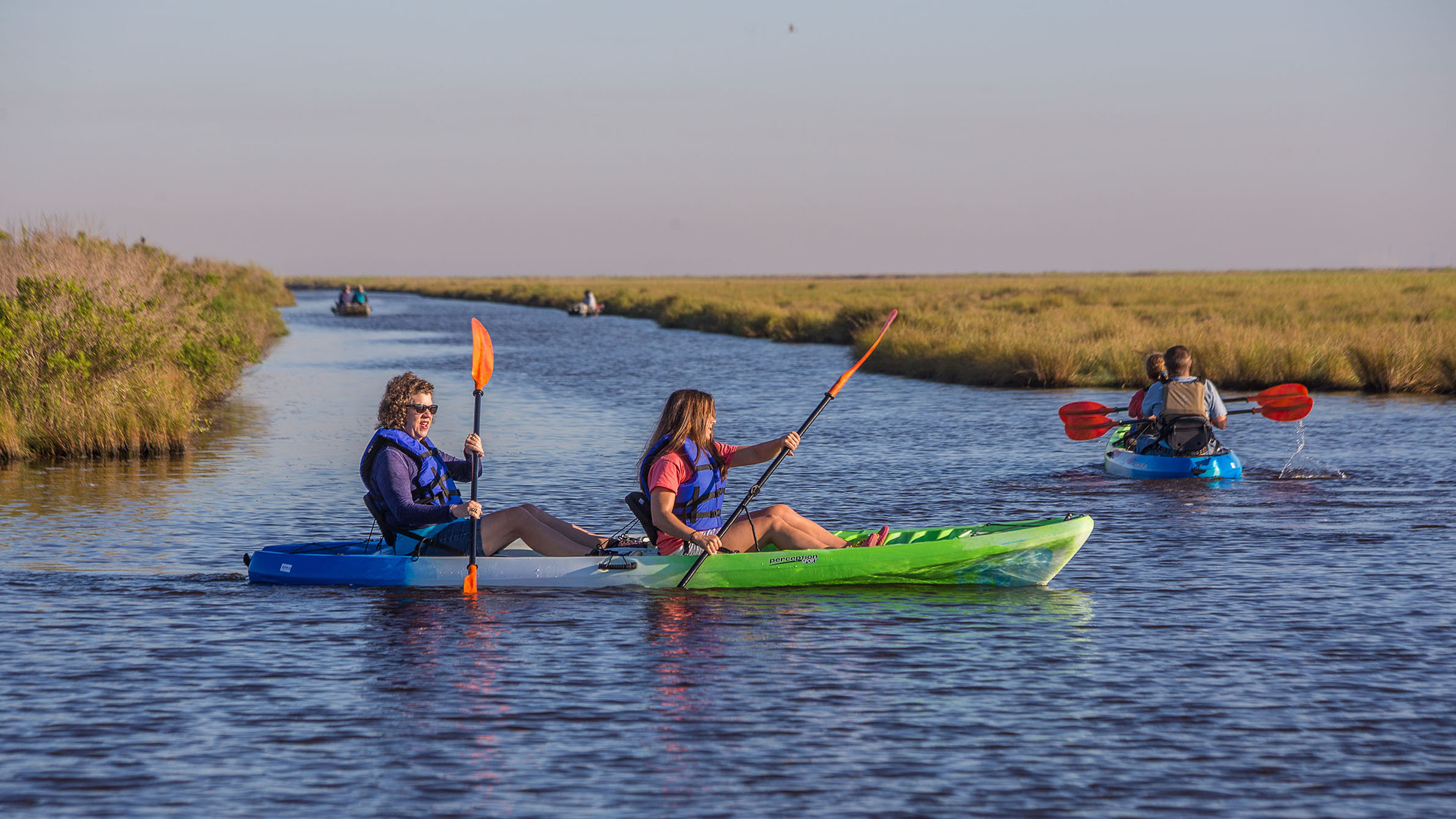
Kayaking at Sea Rim State Park. Photo by Will van Overbeek
The Texas State Parks system marks its 100th anniversary this year. With 89 parks, natural areas, and historic sites to choose from, visitors can experience all kinds of outdoor activities. Each month, we’re highlighting one of these activities based on the season and special occasions around the state.
The narrow, two-lane road to Sea Rim State Park, just south of Port Arthur, passes through mazes of refinery pipes, clusters of cylindrical storage tanks, and looming smokestacks. Abruptly, this industrial scene yields to a swath of green marsh and unimpeded views in all directions. In the 4,000-acre park that runs along the Gulf of Mexico, marsh gives way to dunes and a 5-mile beach that seems to stretch endlessly in either direction.
Beach Cleanup
Participate in the Texas General Land Office’s Coastwide Fall Cleanup on Sept 23. Sign up here and choose Sea Rim as your site. Gloves, trash bags, and a hot dog lunch are provided.
Address:
19335 S. Gulfway Drive, Sabine Pass
Hours: 9 a.m. to noon
Park admission:
$3 adults, children 12 and under free
Website: tpwd.texas.gov/
calendar/sea-rim/
adopt-a-beach
Remote and typically less crowded than some Texas beaches, Sea Rim is a great place to wrap up summer with one last beach visit. It offers camping, kayaking, beachcombing, swimming, stargazing, and birdwatching, but it really shines when it comes to fishing.
Visitors fish in the marsh and the surf. No license is needed to cast a line from shore in a state park (wade into the water or get on something that floats, though, and you need that license). At the park’s headquarters, check out free loaner fishing rods and reels, tackle, and sand spikes to hold your pole, as well as crab lines and nets. The park also has a boat ramp and fish cleaning station.
According to park superintendent Nathan Londenberg, anglers typically catch black and red drum, spotted sea trout, and croakers from the shore. You can keep any catch that meets bag limits and length measurements—find those on the park’s Fishing Tip Sheet. If you aren’t already a fishing enthusiast, this place is likely to turn you into one.
And if not, it holds plenty of other diversions. Sea Rim’s marsh side has paddling trails ranging from under 2 miles to almost 12 (one way), accommodating kayakers of all abilities. The routes go through brackish marsh with tall stands of Gulf cordgrass and phragmite cane and past several small lakes. Paddlers may see alligators, river otters, and birds, including ducks, roseate spoonbills, egrets, and a variety of herons—great blue, little blue, Louisiana, green, black-crowned, and yellow-crowned night herons. Just remember to keep your distance from all wildlife—especially gators!
Single, double, and fishing kayaks with life jackets and paddles are available for rent starting at $15 per hour from a self-serve kiosk. Scanning a credit card automatically opens a locker with paddles and jackets and unlocks the lanyard on the kayak of your choice. Swipe again when you return from your adventure and the system records your time and opens the locker to replace the gear.
Outdoor Vending Solutions runs the kiosk, and managing member John Agor says that if there are any issues with the system, he can open the locks remotely. The Texas-based company, a small business owned and operated by service-disabled veterans, has these kiosks at more than a dozen Texas state parks.
You’ll need a kayak (either a rental or your own) to reach one of the park’s more unique offerings: a floating camping platform. “Float” was designed and built by students in the Gulf Coast DesignLab, an advanced architecture studio at The University of Texas at Austin that offers the opposite of a glamping experience. For instance, in place of a toilet, campers are required to have a 5-gallon bucket and waste bag with enzymes.
But you can expect plenty of privacy at the site. “It is 2 miles from the boat ramp and there is no Wi-Fi out there,” Londenberg says. “It’s rather primitive, so it doesn’t appeal to everybody. Just people who want to get away from it all.” (Read more about the floating campsite in this story from Texas Highways‘ May 2023 issue).
Much easier to access is the Gambusia Nature Trail, a three-quarter-mile boardwalk through a wetland. Park interpreter Madeline Martin notes that the trail is popular with birders, as the park is a stopover for many migratory birds traveling the Central Flyway, a route that brings birds from across North America through Texas on their way south. Fall migration starts in late summer and runs through late October, with many species peaking in September. From the trail, people also may see fish, alligators, crabs, and the namesake gambusia, a mosquito-eating fish. Other residents of the park include mink, muskrat, raccoon, rabbit, opossum, and coyote.
Lodging options include 15 campsites with utilities located behind the dunes, open camping on the beach (no reservations required), and a cabin on the marsh side. The cabin sleeps six (two bunks with a double bed on the bottom and single on top) and has a full kitchen, dining table, bathroom, screened porch with a picnic table, and a grill. Bring your own linens and kitchen supplies. Plenty of places to rest up for one last day at the beach.








